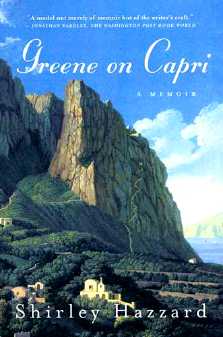|
Greene on Capri,
a memoir / Shirley Hazzard. - New York : Farrar, Straus,
Giroux, 2000. - 149 p.-[8] p. de pl. : ill. ;
22 cm.
ISBN 0-374-16675-7
|
NOTE DE L'ÉDITEUR : When friends die, one's own credentials
change : one becomes a survivor. Graham Greene has already
had biographers, one of whom has served him mightily. Yet I hope
that there is room for the remembrance of a friend who knew him-not
wisely, perhaps, but fairly well-on an island that was « not
his kind of place », but where he came season after
season, year after year ; and where he, too, will be subsumed
into the capacious story.
For millennia the cliffs of Capri
have sheltered pleasure-seekers and refugees alike, among them
the emperors Augustus and Tiberius, Henry James, Rilke, and Lenin,
and hosts of artists, eccentrics, and outcasts. Here in the 1960s
Graham Greene became friends with Shirley Hazzard and her husband,
the writer Francis Steegmuller ; their friendship lasted
until Greene's death in 1991. In Greene on Capri, Hazzard
uses their ever volatile intimacy as a prism through which to
illuminate Greene's mercurial character, his work and talk, and
the extraordinary literary culture that long thrived on this
ravishing, enchanted island.
|
THE
NEW YORK TIMES, February 3, 2000 : […]
But just as evocative is the
picture of Capri composed by Ms. Hazzard's study of Greene, the
island's history, its role as a magnet for expatriates and tourists,
its inhabitants and physical setting. Of one villa they visited
she writes sensuously, « Fersen's in those years was
a garden of mossy textures and dark dense greens, with impasto
of luminous flowers: a place of birdsong and long silence; of
green lizards and shadowy cats, and decadent Swinburnean beauty ».
Most appealing of all is the
picture Greene on Capri paints of a literary life,
not only Greene's but also the author's and her husband's [Francis
Steegmuller]. Some of the best moments in these pages are the
accounts of routines that brought Ms. Hazzard together with Greene:
« It was very pleasant, putting work aside at the
end of the day, changing into fresh clothes, strolling to the
piazza in that scene of sky and sea: the late light, the expectation
of interest and pleasure, the welcome at the restaurant, where
we all preferred to dine, by south Italian summer standards,
quite early ».
Capri is haunted by its past,
Ms. Hazzard makes clear, from the time of the Emperor Tiberius's
exile there in the first century A.D., up through the years in
the early 20th century when Russians established a community
there, among them Maxim Gorky, who had as his guests Chaliapin,
Ivan Bunin and even Lenin.
By the time of Greene's arrival
in 1948, Ms. Hazzard writes, there would never again be « a
literary or artistic 'colony' of closely knit and disputatious
foreigners as in the past, wearing away damp winters at each
other's firesides: gossiping and quarreling, reading and writing
in an ancient and still enchanting place ».
But after reading Greene on
Capri it is hard to imagine visiting the island without
recalling a more immediate past. Such is the intensity of her
memoir that you will see Capri through the eyes of Ms. Hazzard
and be haunted by the spirit of her quarry, Graham Greene.
➙ « Greene on Capri : Isle Haunted by the Past and a Grumpy
Presence »,
review by Christopher Lehmann-Haupt
|
| COMPLÉMENT BIBLIOGRAPHIQUE | | |
|
|
| mise-à-jour : 15 août 2018 |

| |
|